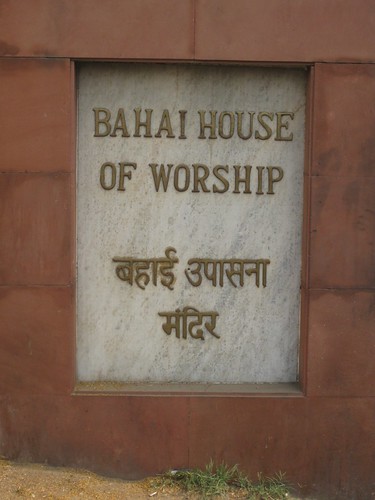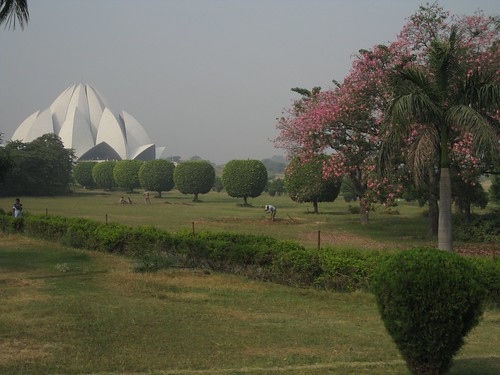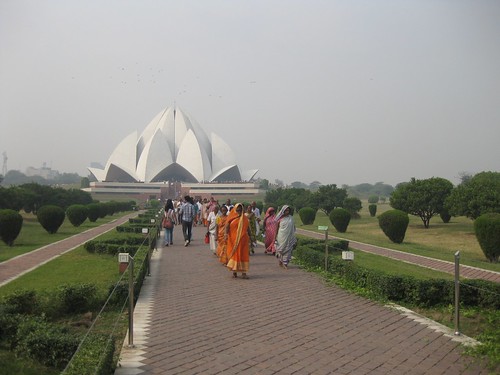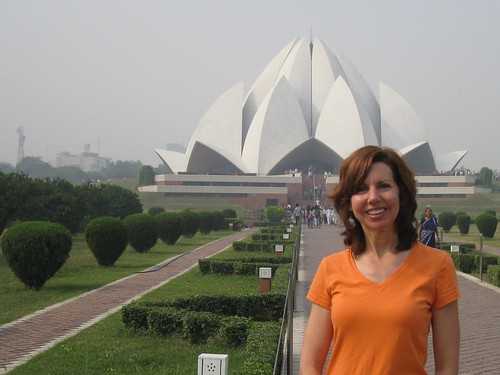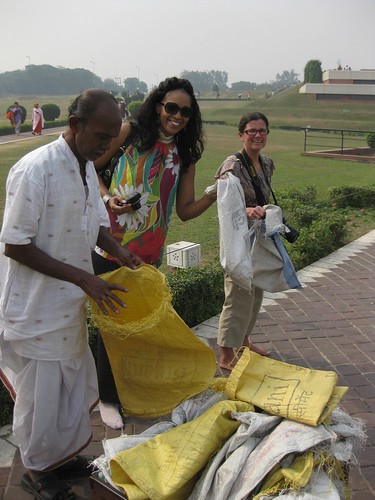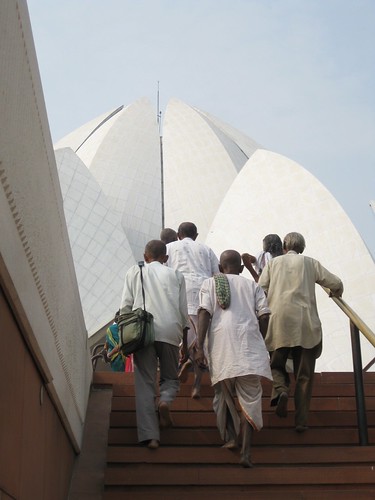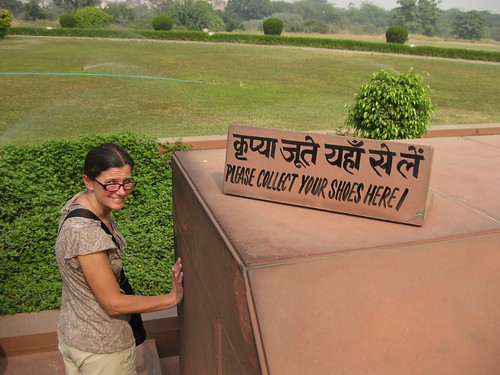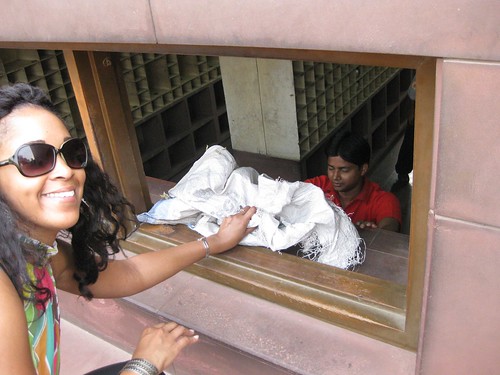Weary of wars in the name of religion and disillusioned by the hypocritical behavior of so-called Christians in America, I visited New Delhi’s Bahá’í House of Worship yesterday both in search of a fresh perspective and to admire its architecture. The building was designed to resemble a lotus flower, so locals refer to it as the Lotus Temple.
Photo courtesy of www.bahaimedia.org.
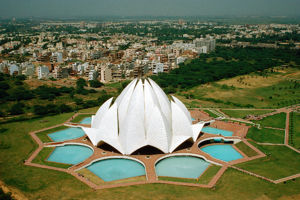
Along with my friends Katrina and Sandra, I checked my shoes at the entrance and walked barefoot up the steps. A woman greeted us in English and gestured for us to join the line. We were the only foreigners in a small crowd of elderly pilgrims who seemed to have come from a different part of the country. The women wore simple colorful cotton saris, and the men dressed mainly in white with long tunics and loose pants or sarongs. As we stood outside, the hostess reminded us that silence was imperative inside the hall. She gave a heartfelt speech about prayer and encouraged us to pray or meditate for as long as we wanted. After repeating the speech in Hindi (I assumed) and pressing his index finger to his lips to hush us, a man opened the doors. We filed in to a huge hall with little ornamentation other than a few plaques featuring Bahá’í quotes and two large flower arrangements at the front lectern. Rows of wooden pews with white marble benches filled the hall, so we took a seat and allowed the tranquility to sink in. Quiet is not an easy thing to find in New Delhi, so this was a special treat. The lotus-petal walls reached up around us while arched perimeter windows filled the hall with natural light.
Photos courtesy of www.bahaimedia.org.
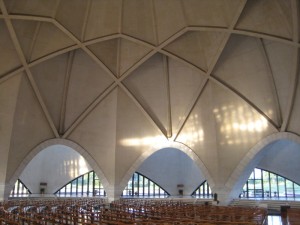
I looked up at the sunburst at the top of the dome. The symbol inside featured three parallel lines intersected down the middle by another line and flanked by two stars.
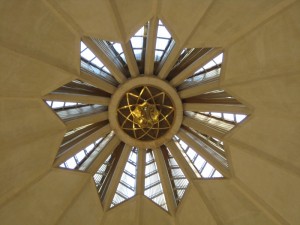
According to Bahá’í Faith, the official website of Bahá’ís in the States, the symbol “serves as a visual reminder of God’s purpose for man, and for Baha’is in particular. The top horizontal bar represents the world of God, the Creator. The middle bar symbolizes the world of His Manifestations, unadorned. The bottom bar represents the world of man. The vertical line joins the three horizantal bars together in the same way that the Divine Messengers of God form the link between the world of God and the world of man. The twin five-pointed stars on either side of the design represent the Bab and Baha’u’llah, the twin Messengers of God for this age.”
After awhile, we wandered back outside and down the stairs to the pools that represent the floating leaves of the lotus. Panels displayed information about Bahá’í philosophies, which were refreshingly inclusive. Although I approach all organized religion with a dose of skepticism, many of the basic principles resonated with me:
* The essential harmony of science and religion
* The common foundation of all religions
* Universal compulsory education
* Equality between men and women
* Elimination of prejudice of all kinds
* The abolition of the extremes of wealth and poverty
* Spiritual solutions to economic problems
For more details, check out the Bahá’í Faith website, which has an excellent section with Frequently Asked Questions.
The Lotus Temple’s website also features interesting information, a video tour and fascinating details about the architecture and construction. It says more than 70 million people have visited the Lotus Temple since its dedication in 1986. Up to 10,000 people come every day! We were fortunate to get there early and avoid the crowds.
After a peaceful exploration of the prayer hall, we reclaimed our shoes and meandered through the information center, where an excellent display of artifacts and interpretive panels further illuminated the Bahá’í religion. Unfortunately, photography was prohibited inside the prayer hall and information center.
People leaving the prayer hall.
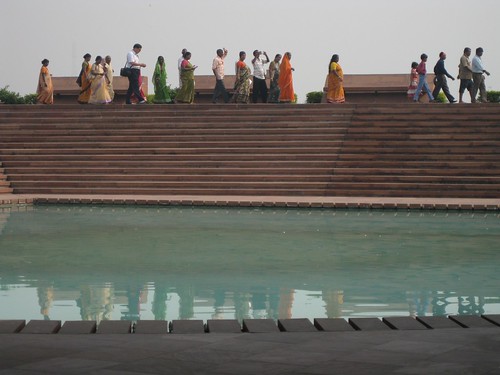
Standing at the prayer hall and looking back at the information center. Haziest sky we’ve seen in New Delhi so far.
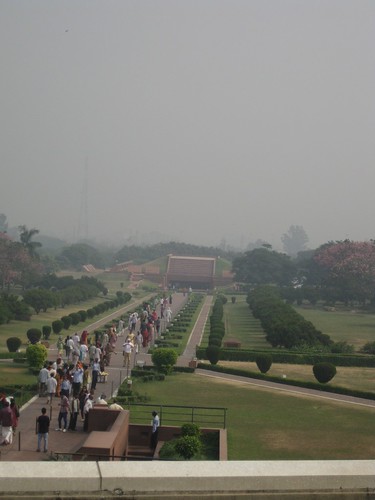
I’ll wrap up this post with a quote from Bahá’u’lláh, who encouraged his devotees more than a hundred years ago: “Consort with the followers of all religions in a spirit of friendliness and fellowship.” A good lesson for us all, indeed.

